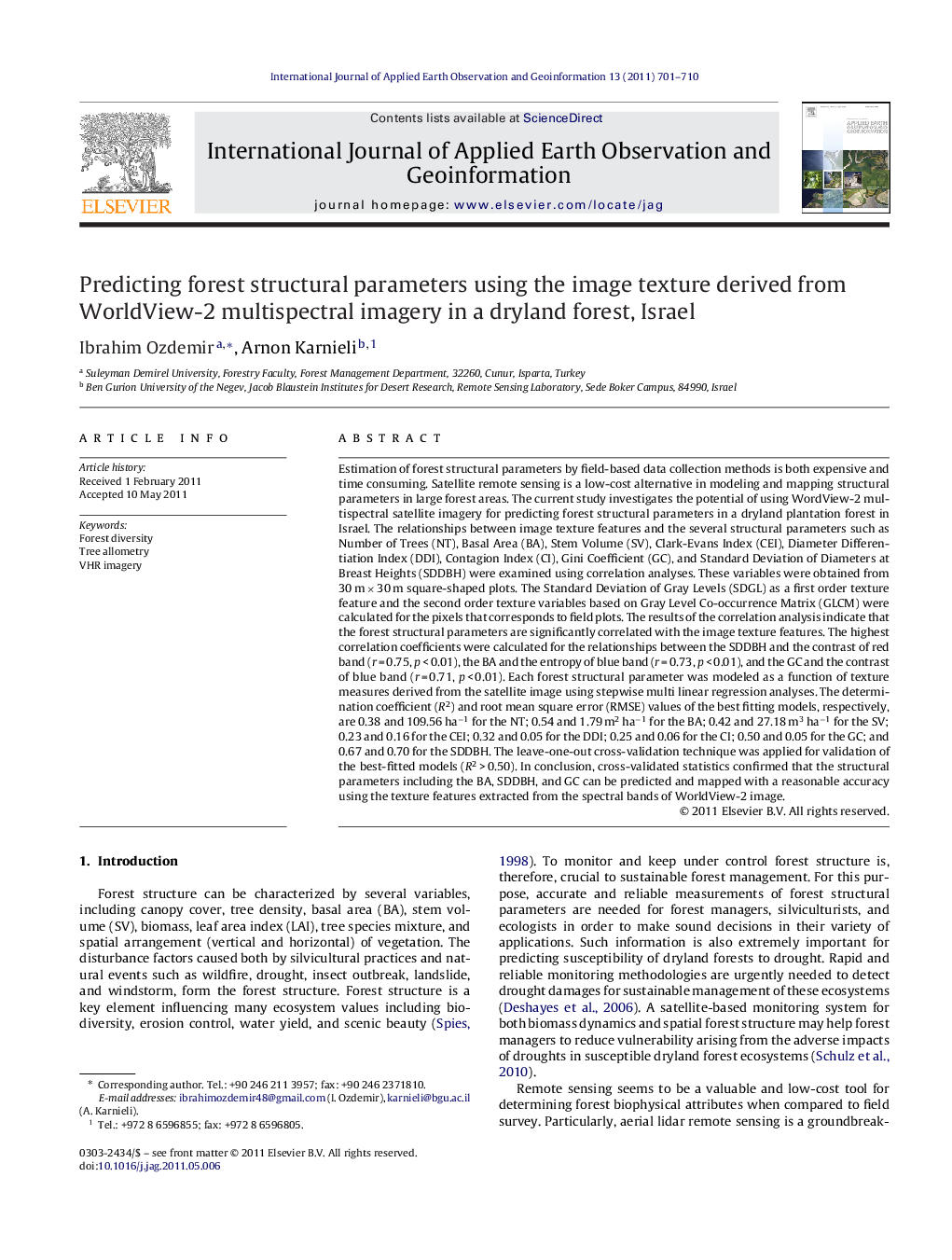| کد مقاله | کد نشریه | سال انتشار | مقاله انگلیسی | نسخه تمام متن |
|---|---|---|---|---|
| 4465082 | 1621848 | 2011 | 10 صفحه PDF | دانلود رایگان |

Estimation of forest structural parameters by field-based data collection methods is both expensive and time consuming. Satellite remote sensing is a low-cost alternative in modeling and mapping structural parameters in large forest areas. The current study investigates the potential of using WordView-2 multispectral satellite imagery for predicting forest structural parameters in a dryland plantation forest in Israel. The relationships between image texture features and the several structural parameters such as Number of Trees (NT), Basal Area (BA), Stem Volume (SV), Clark-Evans Index (CEI), Diameter Differentiation Index (DDI), Contagion Index (CI), Gini Coefficient (GC), and Standard Deviation of Diameters at Breast Heights (SDDBH) were examined using correlation analyses. These variables were obtained from 30 m × 30 m square-shaped plots. The Standard Deviation of Gray Levels (SDGL) as a first order texture feature and the second order texture variables based on Gray Level Co-occurrence Matrix (GLCM) were calculated for the pixels that corresponds to field plots. The results of the correlation analysis indicate that the forest structural parameters are significantly correlated with the image texture features. The highest correlation coefficients were calculated for the relationships between the SDDBH and the contrast of red band (r = 0.75, p < 0.01), the BA and the entropy of blue band (r = 0.73, p < 0.01), and the GC and the contrast of blue band (r = 0.71, p < 0.01). Each forest structural parameter was modeled as a function of texture measures derived from the satellite image using stepwise multi linear regression analyses. The determination coefficient (R2) and root mean square error (RMSE) values of the best fitting models, respectively, are 0.38 and 109.56 ha−1 for the NT; 0.54 and 1.79 m2 ha−1 for the BA; 0.42 and 27.18 m3 ha−1 for the SV; 0.23 and 0.16 for the CEI; 0.32 and 0.05 for the DDI; 0.25 and 0.06 for the CI; 0.50 and 0.05 for the GC; and 0.67 and 0.70 for the SDDBH. The leave-one-out cross-validation technique was applied for validation of the best-fitted models (R2 > 0.50). In conclusion, cross-validated statistics confirmed that the structural parameters including the BA, SDDBH, and GC can be predicted and mapped with a reasonable accuracy using the texture features extracted from the spectral bands of WorldView-2 image.
► We examine the relations between forest structural parameters and the texture features extracted from the spectral bands of WorldView-2 satellite data.
► Stand structural diversity can be modeled using the texture features derived from Gray Level Co-occurrence Matrix.
► The additional spectral bands of WorldView-2 that detect energy in the yellow, red-edge and near infrared regions of the electromagnetic spectrum are very capable at predicting several forest structure parameters.
Journal: International Journal of Applied Earth Observation and Geoinformation - Volume 13, Issue 5, October 2011, Pages 701–710